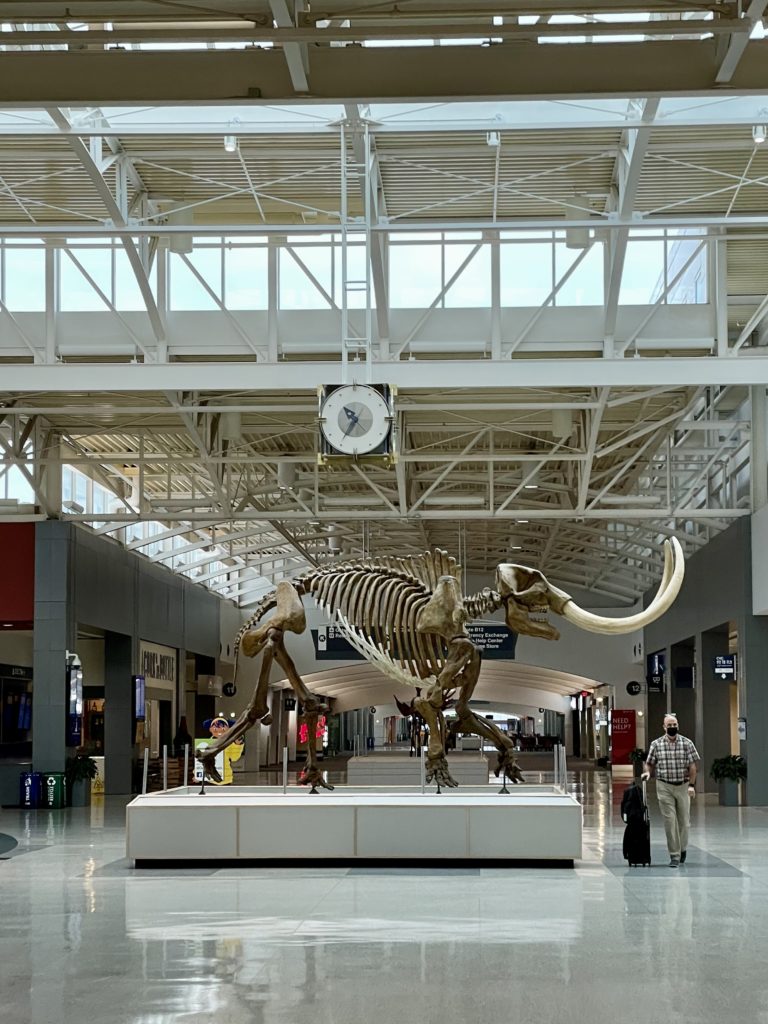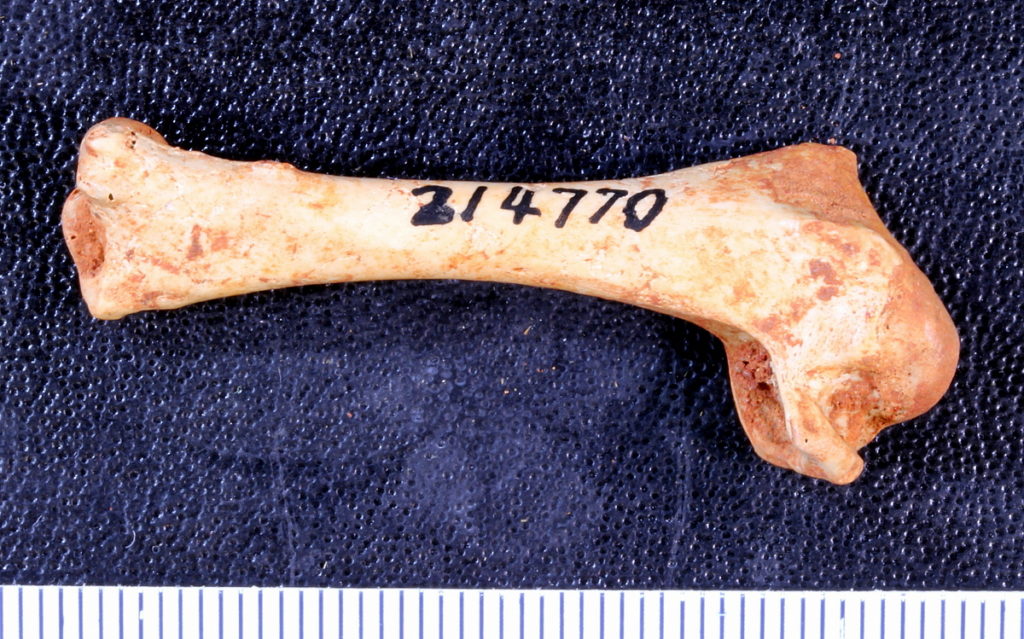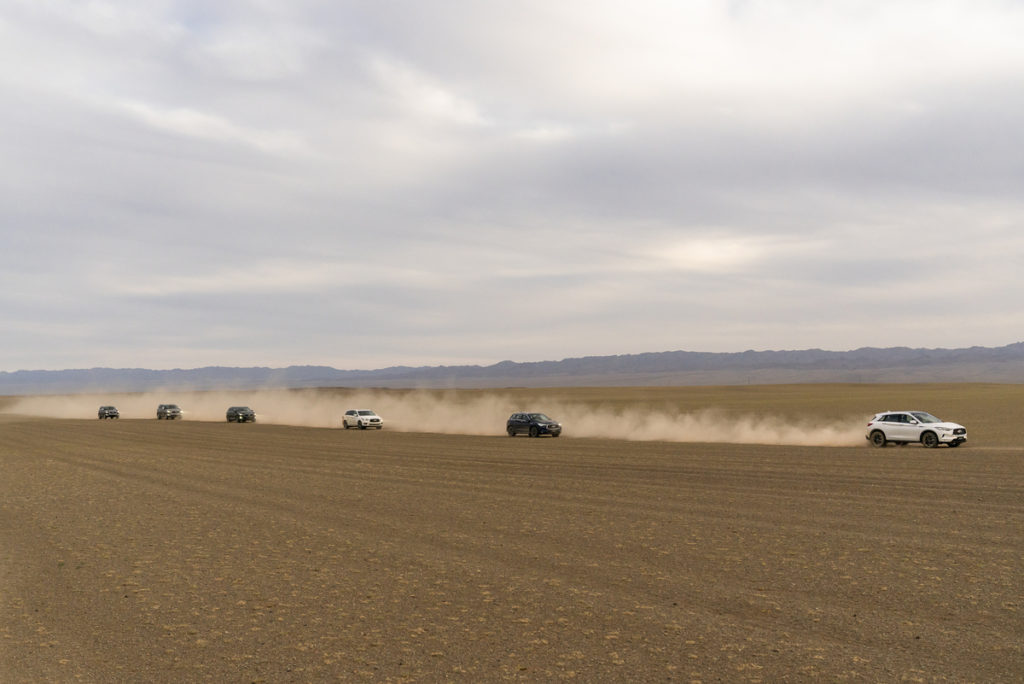Megafauna skeletons on display at the Cincinnati/Northern Kentucky International Airport (CVG), just south of the Ohio River in Boone County, Kentucky). The famous paleontological site, Big Bone Lick, is only about 20 miles south of the airport.



You begin to interest me…vaguely

From the Smithsonian Institution, here’s a passenger pigeon bone, specifically a left humerus (wing). the Smithsonian only identifies it as being from Bartow County, Georgia, but given the collector is attributed to “Lipps et al,” it is likely from Ladd’s Quarry. In the 1960s, Shorter College biology professor Emma Lewis Lipps excavated at this site and sent many fossils to the Smithsonian.
It only took one 13-million-year-old bone for two paleontologists to reconstruct the dramatic encounter pictured above. That bone is a tibia, or lower leg bone, from an extinct ground sloth (not a giant ground sloth, just a 170 pound medium-sized one). The tibia has 46 tooth marks on it, made by the extinct caiman (a close relative of alligators) Purussaurus.
Read the paper by Pujos and Salas-Gismondi to see how, through a detailed taphonomic analysis of a single bone, they were able to infer not only what animal did the biting, but also how old it was. Unresolved: whether the caiman got the whole sloth or just the leg.

Reference:
Pujos F, Salas-Gismondi R. 2020 Predation of the giant Miocene caiman Purussaurus on a mylodontid ground sloth in the wetlands of proto-Amazonia. Biology Letters 16: 20200239. http://dx.doi.org/10.1098/rsbl.2020.0239
Featured image: Detail of Figure 2 from Pujos and Salas-Gismondi. Artwork by Jorge A. González.
I just posted about WPA-era posters created for the U.S. National Parks. One of the great successes of the Depression-era New Deal was how it provided jobs for all Americans, including artists who created lasting works of art like these Post Office murals.
Another beneficiary was the Rutgers Geology Museum. In 1936, the Works Progress Administration funded 21 paintings for the museum by Alfred Poledo, a little-known 1930s artist. Like, there is almost nothing on the Internet about him. There’s this at the Living New Deal, which indicates he was from Boonton, and there’s some census data that shows he was an Italian immigrant, born around 1888 and deceased by 1940.
At least three of his paintings are in the Zimmerli Art Museum at Rutgers University. The mosasaur, an extinct marine reptile whose fossils are found in New Jersey, is featured in two of the pieces, A Lagoon in Jurassic Time and A New Jersey Mosasaur, both dated 1936.
The undated Prehistoric Animals Ready for Battle is the only one that shows dinosaurs. What I presume is a Dryptosaurus (a New Jersey dino related to Tyrannosaurus) faces off against a Triceratops, while some hadrosaurs (the official New Jersey state dinosaur) walk through the background.
These three paintings were donated to the Zimmerli by Helgi Johnson, a professor in the Geology Department who died in 1974. It’s not clear whether the other paintings in the series are also in the Zimmerli or perhaps still at the Geology Museum.
Update: This internship is available again for 2021. Runs from August 1 to October 10, 36-38 hour workweek.
One internship available Ashfall Fossil Beds State Historical Site in Nebraska.

A single internship will be offered for late summer/early autumn for field studies in vertebrate paleontology. With preference to geology or biology students, the position is open to college students with a genuine interest in, and knowledge of vertebrate paleontology, especially those aspiring to further their experience outside of the classroom. Duties include excavation, sorting of micro-vertebrate fossils, prep lab tasks, interpretive duties and other park support tasks.
* 30-34 hour workweek. $11.50 per hour.
* E-mail: rick.otto@UNL.EDU for details and application form.
* Find out more about the Ashfall site at www.ashfall.unl.edu
* Deadline: Applications will be accepted until the position has been filled.

The Explorers Club, Hong Kong Chapter (which for no real reason immediately brought to mind the Flying Elvises, Utah Chapter) and the Mongolian Institute of Paleontology and Geology (IPG) recently teamed up for a twenty day jaunt into the Gobi Desert to look for dinosaur fossil and to commemorate the 100th anniversary of Roy Chapman Andrews’ Central Asiatic Expedition.
Point of order here: On his trip to Mongolia one hundred years ago, Andrews was actually working as a spy for the U.S. Office of Naval Intelligence during World War I. His more famous Central Asiatic Expeditions, where his team from the American Museum of Natural History made so many important paleontological discoveries, including the first dinosaur egg fossils, began in 1922.
That 1918 mission did result in valuable information that helped make his later scientific expeditions to Mongolia so successful – including his conviction that a motorized vehicle expedition was feasible.
In 1858, William Parker Foulke was shown some large bones that had been dug out of a marl pit in Haddonfield, New Jersey, two decades earlier. Foulke and Joseph Leidy then dug up more bones from the site and named the dinosaur Hadrosaurus foulkii. Some earlier, more fragmented dinosaur remains had been found earlier in the nineteenth century, but Hadrosaurus was the first more or less complete dinosaur skeleton.
The original dig site is now in a park in Haddonfield. A plaque, interpretive sign, and a picnic table with toy dinosaurs you can play with commemorate the find. A statue of Hadrosaurus can be found a few minutes away in downtown Haddonfield.
Ashfall Fossil Beds State Historical Park in Nebraska has paid internships available. Ashfall preserves the articulated skeletons of 12-million year old rhinoceros, horses, camels, and deer who died after a volcanic eruption.
Several summer internships are available for field studies in vertebrate paleontology. With preference to geology or biology students, the positions are open to all students with a genuine interest in, and knowledge of vertebrate paleontology, especially those aspiring to further their experience outside of the classroom. Duties include excavation, sorting of micro-vertebrate fossils, prep lab tasks, interpretive duties and other park support tasks.
36-38 hour workweek. $11.50 per hour.
* Three internships will be offered for May 24 to August 10.
* Two internships will be offered for June 20 to September 15.
* One internship will be offered for September 3 to October 20.
Deadline: Applications will be accepted until all positions have been filled, but no later than April 1st. Therefore, advantage to early applicants. Contact the Superintendent at Ashfall for more information.
Publisher Taylor & Francis is offering free access to all 2013 and 2014 articles from 17 Paleontology and Earth Science journals to celebrate both National Fossil Day and the Society of Vertebrate Paleontology and the Geological Society of America annual meetings. Articles will be available for free through the end of 2015.
The ten journals are:
Alcheringa
Australian Journal of Earth Sciences
Geodesy and Cartography
GFF (Geological Society of Sweden)
Geodinamica Acta
Geomatics, Natural Hazards and Risk
Grana
Historical Biology
Ichnos
International Geology Review
Journal of Earthquake Engineering
Journal of Systematic Palaeontology
Journal of Vertebrate Paleontology
Marine Georesources & Geotechnology
New Zealand Journal of Geology and Geophysics
Palynology
Rocks and Minerals
Access the journals here:
Shells and body parts of endangered turtles were identified by paleontologist Don Brinkman, leading to the conviction of the smuggler.
this case — which involved combing through a container with 945 turtle plastrons (bottom part of the shell), 2,454 turtle shells, and 52 bags of turtle fragments within 815 cartons, followed by a second container with 224 bags of fragments in 842 cartons — was the biggest Brinkman has ever worked on.
Full Story at the Calgary Herald.
